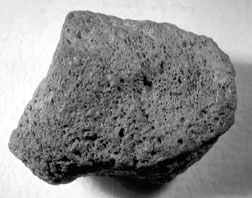|
NEWS NOTES — NEWS
Minerals
Black diamonds have E.T. origins
 |
| Carbonado, or black, diamonds look more like basalt than their traditional colorless counterparts. New research indicates that carbonado diamonds might have formed in space. Photograph is by Steve Haggerty. |
Not all diamonds are created equal, according to a new infrared analysis of the composition of carbonado diamonds. While most colored diamonds, such as the famous blue Hope diamond, have long been shown to originate alongside traditional colorless diamonds deep inside Earth, carbonado, or black, diamonds likely have a more cosmic birthplace, researchers say.
Black diamonds exhibit grey to black surfaces that more closely resemble a lump of coal than the traditional gemstone, but its arrangement of carbon atoms keep it firmly planted in the diamond family.
Still, peculiarities in its location and composition have kept researchers contemplating the rock’s origins. Now, high levels of hydrogen detected in the rock point to formation within a hydrogen-rich region of interstellar space, Jozsef Garai, a geologist at Florida International University and colleagues reported Dec. 20 in Astrophysical Journal Letters.
Debate over black diamonds’ origins stems from the rocks’ tendency to break the rules: Diamonds of terrestrial origin are known to form under the high temperature and high pressure conditions deep inside Earth, where they are eventually carried to the surface through vertical pipes that result during some volcanic explosions. Black diamonds, however, are not associated with such pipes, instead turning up in a single layer of sediment in Brazil and the Central African Republic. Also, while most diamonds form as a single crystal, black diamonds form from numerous tiny crystals clumped together, giving carbonado its dark look.
To learn more about black diamond’s origins, Garai and colleagues sought to more thoroughly investigate its composition by subjecting samples of the rock to infrared radiation. Based on how the sample absorbed the radiation, the researchers determined the presence of specific elements, notably hydrogen, which they surmised was likely incorporated into the structure during its formation. The hydrogen signature closely matched that present in tiny diamonds known to exist in meteorites.
The close match to meteoritic diamonds suggests that black diamonds, too, got their start in space, Garai says. That diamonds exist in space is not a surprise, as micro-sized diamonds have long been known as a common component inside meteorites, as well as within the dust in outer space.
Some researchers, however, are less certain about the finding’s cosmic explanation. “I think it’s a huge leap from saying you have a hydrogen-rich environment to saying you form it in this interstellar medium,” says Conel Alexander, a cosmochemist at the Carnegie Institute of Washington’s Department of Terrestrial Magnetism, who studies the chemistry of meteorites. Instead, the diamonds could have formed from organic- and hydrogen-rich sediments on Earth that underwent an extreme pressure event, such as from a meteor impact. “At high pressure, you could probably do all sorts of interesting chemistry,” he says.
Whether black diamonds are of terrestrial or extraterrestrial origin will likely continue to be debated. Still, “carbonado diamonds are a very strange material, certainly, by typical terrestrial standards — of that there’s no doubt,” Alexander says.

 Subscribe
Subscribe


